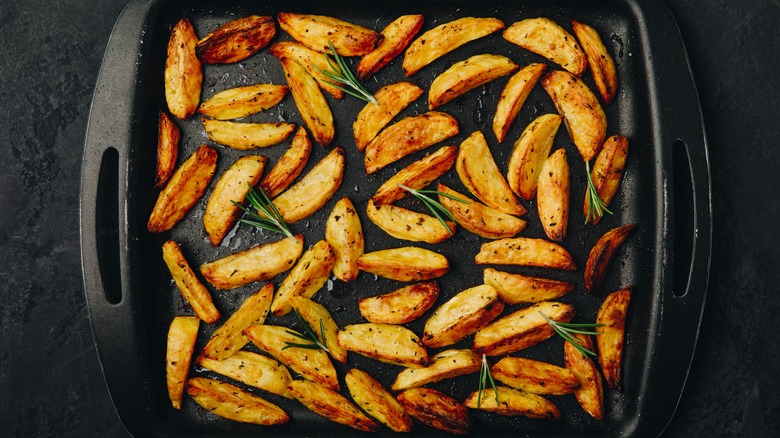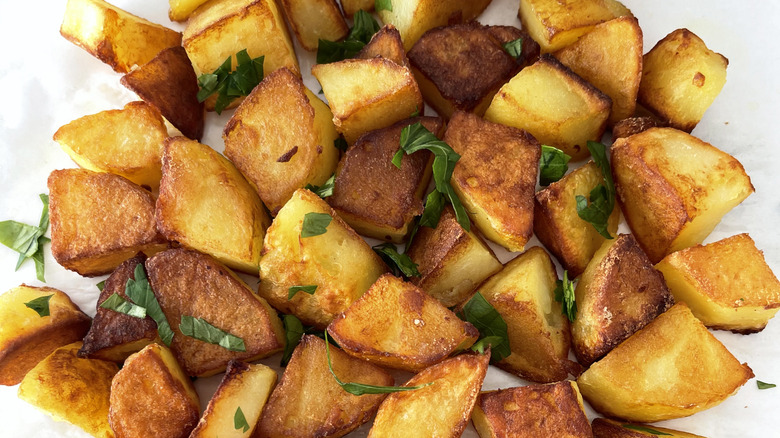Why You Shouldn't Bake Crispy Potatoes In A Glass Dish
Roasting potatoes in the oven delivers the perfect textural contrast of crispy, crunchy exteriors, and a steamy, pillowy soft interior. While plenty of cooks and recipe developers have weighed in on the best types of potatoes, seasonings, and oven temperatures to achieve the crispiest roasted potatoes, the type of baking dish you use is an equally important variable of success. You should always use a metal baking sheet or dish when baking crispy potatoes, and not a glass dish.
Glass dishes are wonderful heat insulators for long, low-temperature baking projects like pies, crumbles, and lasagna. They'll even keep food hot long after they come out of the oven. However, the glass will not hold up to high-heat baking. You could risk shattering glassware if you put it into a super-hot oven. Furthermore, glass will not evenly distribute high heat to potatoes as they roast, which translates to soft edges and, sometimes, unevenly cooked pulp.
Where glass insulates heat, metal is a well-known heat conductor. Consequently, metal baking sheets are optimal for high-heat recipes like roasted potatoes because they will effectively and efficiently transfer the high heat evenly, resulting in those desirably crispy-edged potatoes. Metal baking sheets are also ideal for placing under a broiler, which is a common step in recipes for crispy potato edges.
Metal baking sheets come in aluminum and stainless steel varieties. Both are acceptable for crispy potatoes, but aluminum metal pans can get hotter and cook potatoes faster than stainless steel.
More prep and cooking tips for crispy potatoes
While metal baking sheets will help you achieve the crispiest potato edges, they're only one factor. The temperature of your oven, oven rack placement, and additional preparation hacks are other factors to consider in your quest for crispy edges. Just as we've established that metal pans are the best conductors for high-heat baking, you can then deduce that roasting crispy potatoes requires high temperatures.
Temperatures between 425 and 450 degrees Fahrenheit are ideal for crisping potatoes, but you'll want to place the baking sheets in the middle rack of the oven. Since you're roasting potatoes at high temperatures, you'll also want to be cognizant of additional seasonings; using powdered garlic instead of fresh garlic will mitigate burning. That said, if you want to use fresh aromatics and herbs, you can sautee them in oil while the potatoes roast, then drain the oil and sprinkle the seasonings over the roasted potatoes. You could also create an aromatic-infused dipping sauce.
Another useful hack is to preheat the baking sheet to help potatoes get a jumpstart on crisping up in the oven. Parboiling potatoes for a few minutes before tossing them in oil and seasonings is a popular tip for crisping potatoes because it creates a layer of starch around the exterior of the potatoes that dry heat will effectively transform into shatteringly crispy, browned edges. You can toss the parboiled potatoes in cornstarch or flour for even more crisping fodder.

